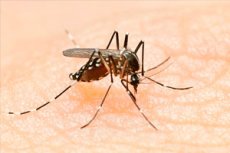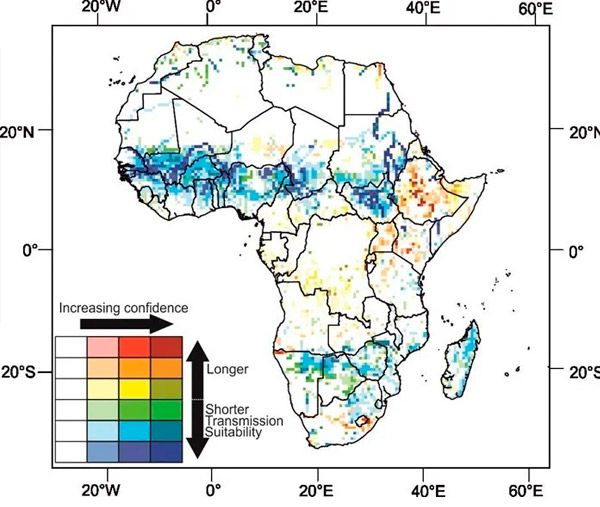New model predicts the impact of climate change on malaria transmission in Africa
最近審查:14.06.2024

A new model predicting the impact of climate change on malaria transmission in Africa could lead to more targeted interventions to control the disease, according to a new study.
Previous methods used total rainfall to indicate the presence of surface water suitable for mosquito breeding, but the study, led by the University of Leeds, used several climate and hydrological models to account for the real processes of evaporation, infiltration and flow through rivers.
This breakthrough approach has created a deeper understanding of the conditions favorable to malaria on the African continent.

Projected changes in the length of the season suitable for malaria transmission by 2100 under a high-emissions scenario. Red shades indicate an increase in season length, while blue shades indicate a shortening season length. The intensity of the color indicates confidence in the estimates. Image credit: University of Leeds
He also highlighted the role of waterways such as the Zambezi River in the spread of the disease, with nearly four times more of the population estimated to live in areas suitable for malaria for up to nine months a year than previously thought.
The study, "Future Environmental Suitability for Malaria in Africa Is Sensitive to Hydrology," was funded by the National Natural Resources Board and published May 9, 2024 in Science.
Dr Mark Smith, associate professor of water research in the Department of Geography at the University of Leeds and lead author of the study, said: “This will give us a more realistic estimate of where in Africa it will get better or worse for malaria.
"And as more detailed estimates of water flows become available, we can use this understanding to guide priorities and tailor malaria interventions in a more targeted and informed way. This is really useful given the often limited health resources."
Malaria is a climate-sensitive vector disease that caused 608,000 deaths among 249 million cases in 2022.
95% of global cases are in Africa, but the decline in cases there has slowed or even reversed in recent years, partly due to stagnant investment in the global malaria control response.
Researchers predict that hot, dry conditions caused by climate change will lead to an overall reduction in areas suitable for malaria transmission starting in 2025.
The new hydrology-based approach also shows that changes in suitability for malaria occur across different locations and are more sensitive to future greenhouse gas emissions than previously thought.
For example, the projected reduction in suitability for malaria in West Africa is more extensive than predicted by rainfall-based models, extending east to South Sudan, while the projected increase in South Africa is now thought to follow water courses such as the Orange River.
Co-author of the study, Professor Chris Thomas, from the University of Lincoln, said: "A key advance is that these models take into account that not all water stays where it rains, meaning that breeding conditions suitable for malaria mosquitoes may also be more widespread - particularly along major river floodplains in the dry savannah regions that characterise many parts of Africa.
"What's surprising about the new modelling is the sensitivity of the length of the season to climate change - this could have dramatic implications for the amount of disease transmitted." Simon Gosling, professor of climate risk and environmental modelling at the University of Nottingham, co-author of the study and who helped coordinate the water modelling experiments used in the study.
Our study highlights the complex way in which changes in surface water flows are changing the risk of malaria transmission across Africa, made possible by a major scientific programme led by the global hydrological modelling community to compile and provide estimates of the impacts of climate change on water flows across the planet.
While the overall reduction in future malaria risk may sound like good news, it comes at the cost of reduced water availability and a greater risk of another significant disease, dengue.

